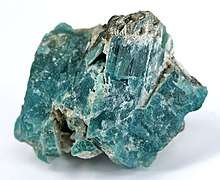Grandidierite
Grandidierite is a rare mineral that was first discovered in 1902 in southern Madagascar. The mineral was named in honor of French explorer Alfred Grandidier (1836–1912) who studied the natural history of Madagascar.[1]

| Grandidierite | |
|---|---|
 Tabular crystals of grandidierite from the type locality in Madagascar | |
| General | |
| Category | Nesosilicate |
| Formula (repeating unit) | (Mg,Fe2+)Al3(BO3)(SiO4)O2 |
| Strunz classification | 9.AJ.05 |
| Dana classification | 54.01.01.01 |
| Crystal system | Orthorhombic |
| Crystal class | Dipyramidal H-M symbol: (2/m 2/m 2/m) |
| Space group | Pbnm |
| Identification | |
| Color | Cyan to turquoise; bluish green |
| Twinning | none |
| Cleavage | Perfect |
| Fracture | Brittle |
| Mohs scale hardness | 7.5 |
| Luster | Vitreous, pearly |
| Streak | White |
| Diaphaneity | Transparent to translucent |
| Specific gravity | 2.976 |
| Optical properties | Biaxial (-) |
| Refractive index | 1.583 - 1.639 |
| Pleochroism | Visible |
| 2V angle | Measured: 24° to 32°, calculated: 32° |
| Dispersion | strong r < v |
| References | [1][2][3] |
Grandidierites appear bluer in color the more iron (Fe) they contain. A recently discovered gemstone, blue ominelite is the Fe-analogue (Fe, Mg) to grandidierite (Mg, Fe).[4]
Grandidierites display strong trichroic pleochroism. That means they can show three different colors depending on the viewing angle: dark blue-green, colorless (sometimes a very light yellow), or dark green.
While trichroism can usually help distinguish grandidierites from other gems, lazulites can occur with blue-green colors and show colorless/blue/dark blue pleochroism. Nevertheless, lazulites have somewhat higher refractive indices and specific gravity. Grandidierites also have greater hardness.